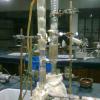Hi,
I am working on the design of a neutralisation process in a batch tank. The operators/owners would like to run the tank at a low liquid level and add acids to a neutral or basic solution. They would like to monitor temperature and if there is any indication that the temperature gradient is too steep (indicating excessive reaction) they would like to add unmetered quench water to cool and dilute the reaction. This would be controlled by a simple on/off solenoid valve. When the temperature is back in the acceptable range, the water is stopped. The proposed operating liquid level is around 10% of the total volume. There should also be a high level switch present to raise a LAHH alarm and stop the water.
My concerns are around this as a valid control scheme. If the temp is still rising and the TIC calls for water AND the level is high enough to trip the LAHH, then surely I have to set a priority.
One option is to run the solution through a cooling HX, but I am concerned about undissolved solids building up in tubes or plates. Sufficiently cold water is not available to be able to use internal tank coils and the tank will be fibreglass so jacketing is not an option.
Any suggestions on whether the proposed scheme is workable?
Regards
Raoul

 FB
FB










